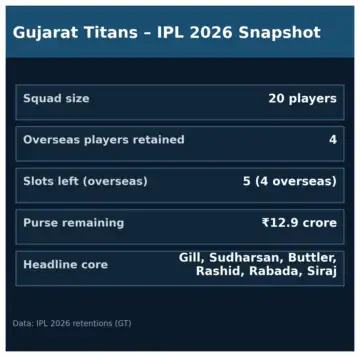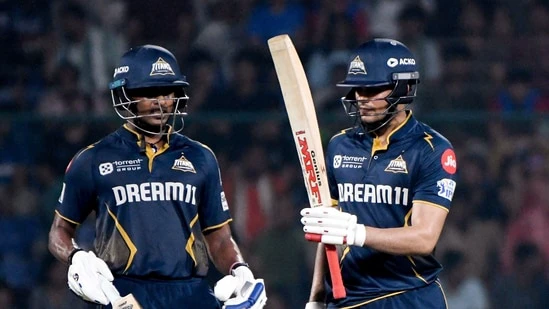The Gujarat Titans have chosen calm over chaos. While other franchises rip up blueprints after bad seasons, GT will be walking into the 2026 mini-auction with most of their dressing room intact and a clear belief that there is enough to give them a shot at the trophy in the upcoming edition.
They have retained 20 players, released just five, traded out Sherfane Rutherford, and now head to Abu Dhabi with an INR 12.9 cr purse and five open slots. The question now is brutally simple: is this continuity a competitive edge – or quiet complacency in a league that punishes standing still?
GT’s 2026 snapshot: continuity with a thin wallet
 Gujarat’s retention list reads like a spine: Shubman Gill (c), Rashid Khan, Sai Sudharsan, Jos Buttler, Kagiso Rabada, Mohammed Siraj, Prasidh Krishna, Rahul Tewatia, Shahrukh Khan, Washington Sundar, Sai Kishor and more. It’s essentially a full playing XI plus specialist depth in spin and Indian pace, already signed and sealed before the auction even begins.
Gujarat’s retention list reads like a spine: Shubman Gill (c), Rashid Khan, Sai Sudharsan, Jos Buttler, Kagiso Rabada, Mohammed Siraj, Prasidh Krishna, Rahul Tewatia, Shahrukh Khan, Washington Sundar, Sai Kishor and more. It’s essentially a full playing XI plus specialist depth in spin and Indian pace, already signed and sealed before the auction even begins.
The surgery has been minimal. Dasun Shanaka, Mahipal Lomror, Karim Janat, Gerald Coetzee, and Kulwant Khejroliya are out; Rutherford has been traded to the Mumbai Indians, creating a clear vacancy in middle-order power.
To judge whether GT have been smart, we use our metrics: Retention Value Score (RVS) and Release Risk Score (RRS). RVS is a 10-point scale that rates how wise it was to retain a player by blending role, age, scarcity, impact and price. RRS flips the lens: it measures how badly a released player can haunt a franchise if it fires somewhere else.
Reviewing the retentions of GT for IPL 2026
 GT look stacked in all the right places. Shubman Gill sits at the top of that chart: a young captain, bankable top-order run machine and brand figurehead, easily a 9.5/10 retention. Alongside him, Sai Sudharsan has evolved from an exciting prospect to a high-volume left-hand anchor, giving GT one of the most stable opening pairings in the league. RVS 9/10
GT look stacked in all the right places. Shubman Gill sits at the top of that chart: a young captain, bankable top-order run machine and brand figurehead, easily a 9.5/10 retention. Alongside him, Sai Sudharsan has evolved from an exciting prospect to a high-volume left-hand anchor, giving GT one of the most stable opening pairings in the league. RVS 9/10
Layered on that is the global firepower. Jos Buttler boosts their RVS as a flexible, matchup-proof T20 giant who can open or float. His presence gives the batting order the flexibility they can use as per the conditions of a game. RVS 9/10
With the ball, the RVS story is just as strong. Rashid Khan remains a strategic non-negotiable: even after a relatively quiet 2025 by his standards, his career profile keeps him in the 8.5/10 zone.
Around him, GT have doubled down on an Indian pace cartel of Siraj and Prasidh Krishna, with KG Rabada in the mix. All these players have been retained on significant deals to ensure they don’t ever walk into a match under-gunned with the new ball or through the middle overs.
Add to this the all-rounder arsenal of Rahul Tewatia, Shahrukh Khan, Washington Sundar, Sai Kishore, Nishant Sindhu and Arshad Khan, and the picture that emerges is of a franchise that has consciously hoarded players who tick multiple boxes at 5,6 and 7 – even if none of them is yet a full-proven end-overs monster on their own.
Looking at the releases of GT for IPL 2026
 On the RRS side, GT’s individual exits aren’t as dramatic as CSK losing Ravindra Jadeja or Matheesha Pathirana – but the pattern is a bit risky.
On the RRS side, GT’s individual exits aren’t as dramatic as CSK losing Ravindra Jadeja or Matheesha Pathirana – but the pattern is a bit risky.
The most obvious medium-to-long-term regret candidate is Gerald Coetzee. Letting go of a 150 kmph quick with lower-order hitting and age on his side gives him an RRS of 8/10. Not because of what he has already done in teal, but because of what he could become elsewhere in a league starved of true express pace.
The Sherfane Rutherford sits on tier below that but still matters. In isolation, his numbers are replaceable; in context, GT have willingly created a hole in the finishing slot, which now pushes even more pressure onto Tewatia and Shahrukh. His RRS stands at 9/10.
Sharp, stable but one bad auction from trouble
One paper, GT’s RVS grid, is one of the strongest in the league: a young Indian batting core, world-class spin, high-end Indian pace and a thick layer of all-rounders already under contract. They have deliberately insulated themselves against auction chaos by doing most of their serious business early.
But the RRS alarm doesn’t come from one blockbuster release; it comes from role gaps that can turn a finished squad into a fragile one. If Gujarat nail an overseas finisher and a death-overs specialist in the auction, this continuity will look genius. If they don’t, IPL 2026 might read like a sequel to 2025 – brilliant for long stretches but a season that slips away in the last five overs and the last five games.
